Cruising allows you to discover new favorite foods as you travel. Whether you’re getting your first taste of lion fish or jicama, it helps to have someone show you how to prepare it properly. In today’s post, Amy Alton shares techniques to help you prepare breadfruit along with a couple recipes that allow you to make the most of it.
If you’ve cruised the South Pacific, you’ve probably noticed a breadfruit tree and admired its qualities; the trees grow tall with glossy, lobed leaves in a multitude of green shades. But the fruit looks odd hanging off the ends of the branches, weighing the tree down.It’s round, hard, and heavy, with scaly green skin. But this fruit, originally native to New Guinea, holds a wealth of nutrients in its versatile flesh.
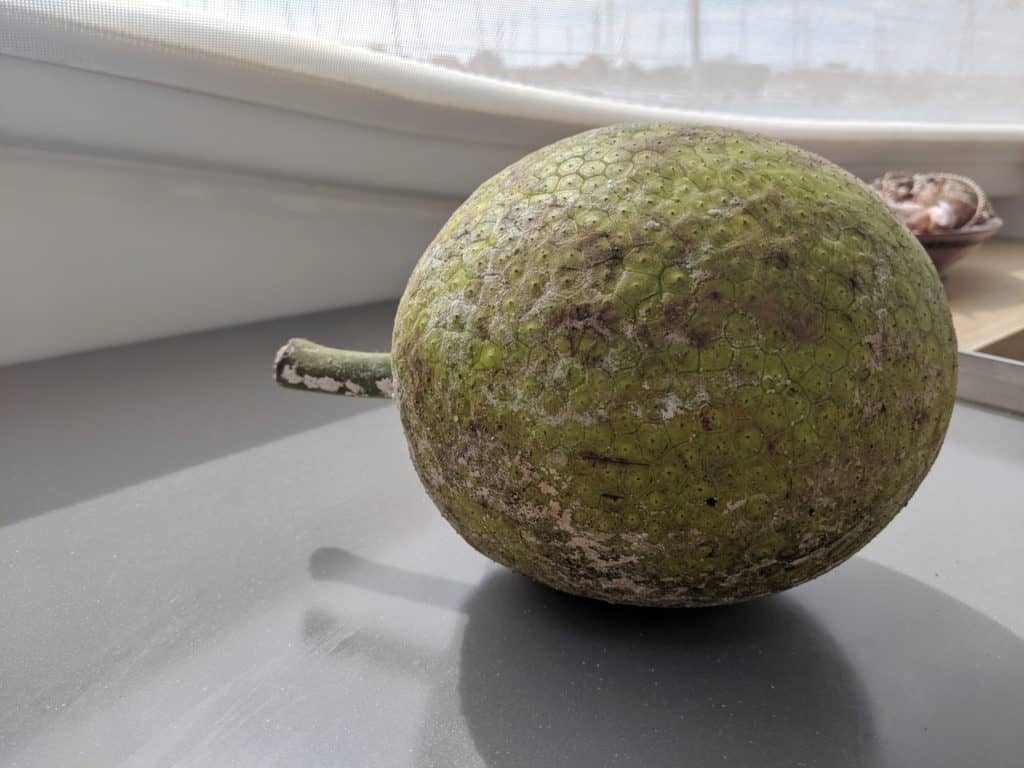
The plant spread throughout Asia and the Pacific and eventually was brought to the Caribbean by the British. It grows well in the tropics and is one of the highest-yielding fruit plants. It produces throughout the year and one tree can yield up to 450 pounds of fruit. This has provided the world with an easy-to-grow, high carbohydrate food source.
When I encounter breadfruit, it’s usually at the local vegetable market. Most commonly it’s sold when fairly large (soccer ball size), green and mature. Baby breadfruit tastes like artichokes, while soft and brown ripe ones taste sweet. The standard offering tastes like sweet potatoes.
Breadfruit is high in complex carbohydrates and has a lower glycemic index compared to other white starches. Just a ½ cup of breadfruit provides 25% of your daily recommended fiber intake. Easting local breadfruit is a great way to eat healthily and cut down on the carbon footprint of your food.
How to Prepare the Breadfruit
These instructions are for your typical mature breadfruit. It’s much like preparing a pineapple with its hard outer skin and an inner core.
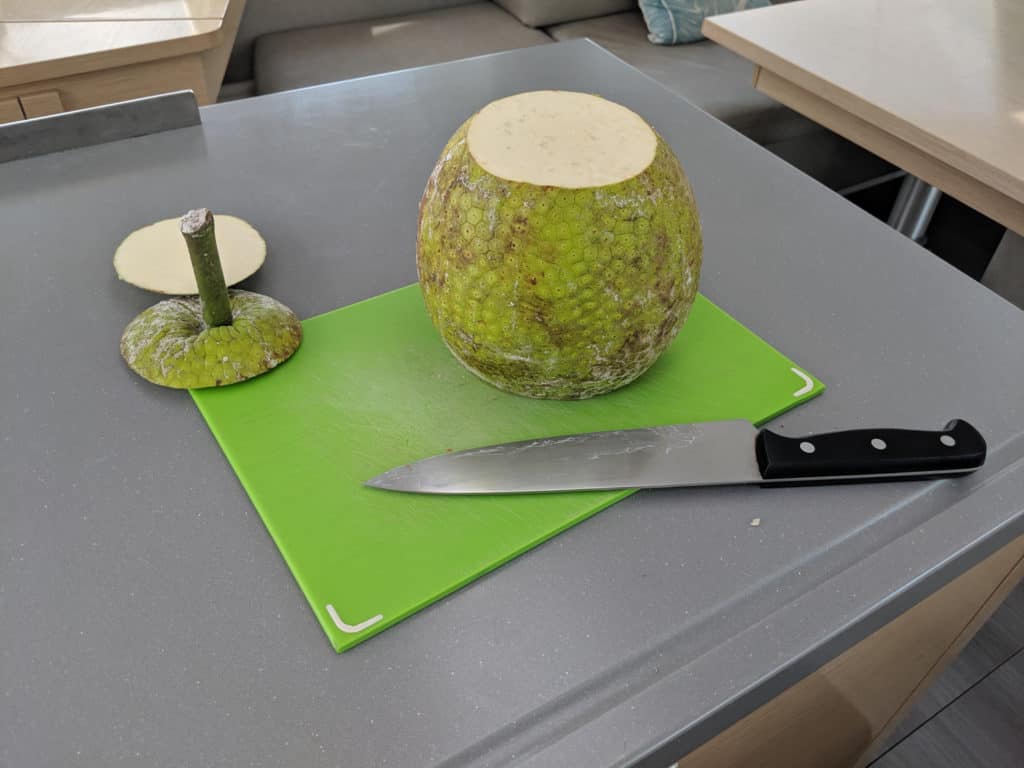
First, I cut the top and bottom off.
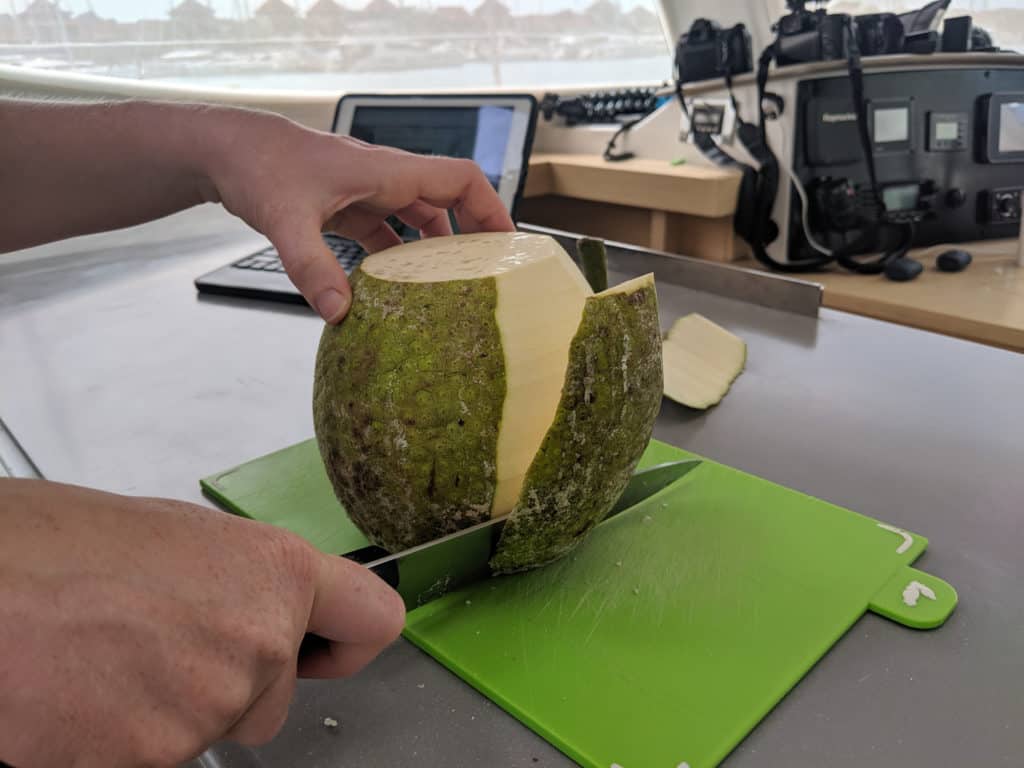
Then, I work around the fruit cutting the skin off. A sap is released, although it’s not as sticky and thick as some other produce, you will notice it leaving a residue behind.
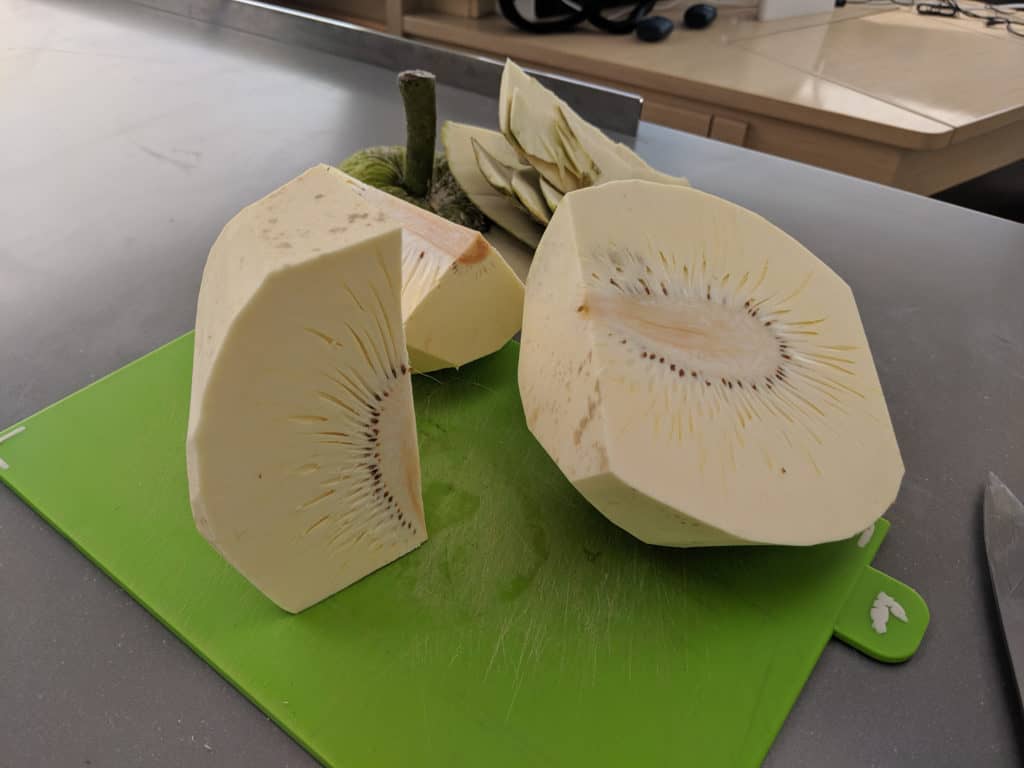
Cut the fruit into quarters lengthwise.
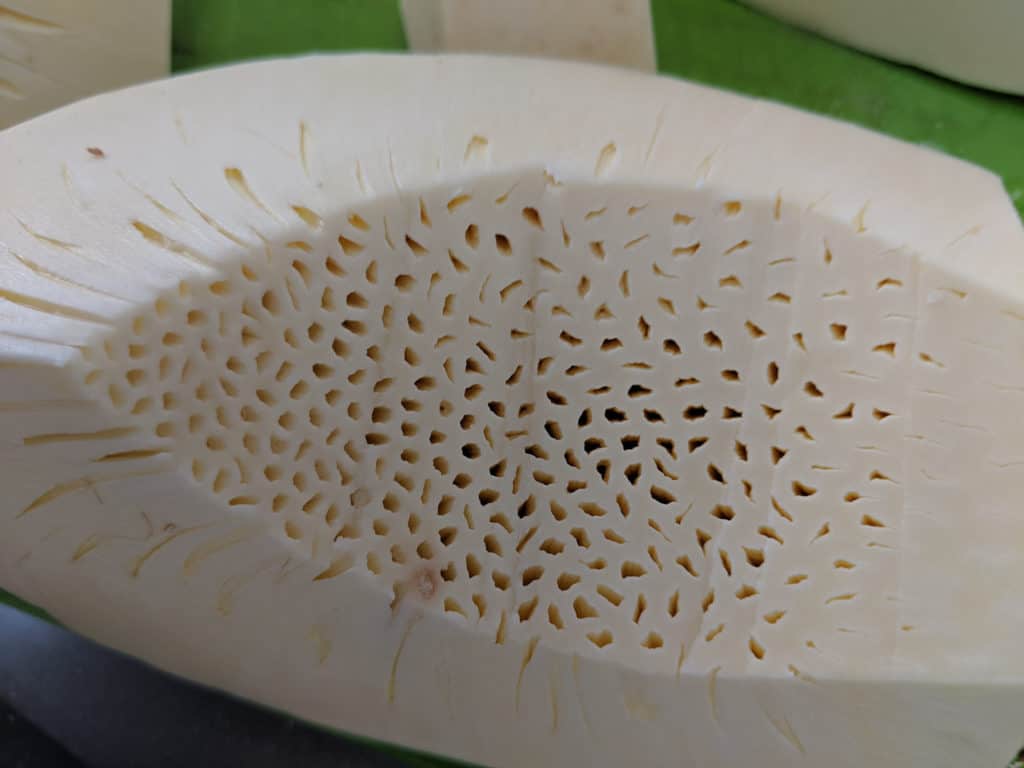
The fruit is dense in the middle, then porous, then solid flesh. We want to cut out the dense middle part and throw it away, leaving the edible porous and solid flesh. Here there are small brown seeds with hairs that extend out into the porous part. If you desire, you can cut out the porous part as well, for aesthetic purposes. I often see breadfruit chips made with the porous part and I like it. I also wash the breadfruit here, as the little hairs tend to get everywhere.
That’s it! You now have four large chunks of breadfruit to cook with.
Four Easy Ways to Cook Breadfruit
Once you’ve followed the instructions for peeling and prepping the breadfruit, try a few of my favorite ways to cook it:
- Dice the breadfruit, toss with olive oil and salt and bake until browned.
- Steam the breadfruit and mash it.
- Pan fry chunks of breadfruit with oil.
- Throw a whole breadfruit into your beach bonfire and pull it out when the skin is black.
If you’re more ambitious, here are two easy recipes to try.
How to Make Breadfruit Chips
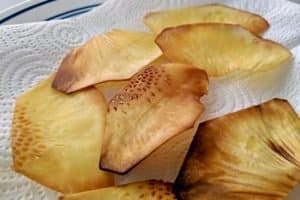
Breadfruit Chips
Ingredients
- ½ breadfruit
- ½ cup Oil or more as needed (coconut or neutral oil)
- Salt
Instructions
- Slice the breadfruit quarters thinly. If you have a mandoline onboard, use it!

- Heat oil in a wide pan (like your Magma 9-1/2 inch frying pan) on your stove on medium-high heat. I use coconut oil and start with ¼ cup.

- Lay your breadfruit slices in the hot oil in a single layer. Because I use a mandoline, my slices are very thin, and brown quickly. Flip to brown on both sides. You will notice the slices start to curl up the darker brown they get.

- When the chips are stiff and light brown, use your tongs to remove your breadfruit chips from the oil and transfer to a paper towel covered plate.

- Repeat for all your slices. Salt and serve!
Making Breadfruit Curry
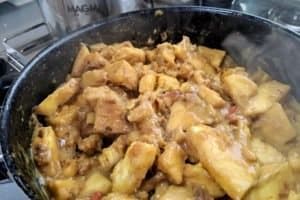
Breadfruit Curry
Ingredients
- 2 Tbs coconut oil
- 4 cloves of garlic, minced
- 1 knob of fresh ginger, minced 1”x1”x2” size
- ½ onion, diced
- ½ bell pepper, diced
- ½ breadfruit, cut into small chunks
- 1 can coconut milk (13.5 ounce size)
- ½ tsp turmeric
- ⅛ tsp chili powder (optional)
- 2 Tbs curry powder
- ½ water, or more as needed
Instructions
- Heat the oil in a saucepan or stockpot using medium-high heat.

- Add garlic, ginger, onion, and pepper to oil and let cook for five minutes, stirring occasionally.

- Add the breadfruit and let it cook for a few minutes, stirring until most of the pieces are browned.

- Pour in coconut milk, spices, and water. Bring to a boil.

- Turn the heat down, cover, and let simmer for 20-30 minutes until the breadfruit is soft when poked with a fork. It should feel like a cooked potato. If your sauce gets too thick, add more water and stir.
- Serve with chapati or rice.

I hope these instructions and recipes have given you the courage to try breadfruit. Who knows what other interesting preparations you can find as well.
Amy Alton writes the blog Out Chasing Stars. She and her husband are in the final stretch of their circumnavigation on their 44-foot catamaran, Starry Horizons. Their adventures over the past five years have brought them through the Caribbean, South Pacific, Southeast Asia, and the Indian Ocean. They share their adventures on YouTube and Facebook.
Simplify meal prep on board with proven strategies for provisioning, maximizing fridge space, and cooking delicious meals aboard your boat.


















Carl John says
I am from the Caribbean and regularly eat breadfruit; roasted, fried, salad, or as part of our national dish (oil down) but never curried. I love the looks of your recipe and would try it as soon as one if found.
Thank you
Fran says
We have lived in the Caribbean and South Pacific for 34 years and love breadfruit.Try it instead of potatoes in potato salad Fran SY “AKA”
Pat says
Just made some. This stuff is so nasty tasting by itself I thought I can see why it has to be disguised with a lot of spices! Then it still had that underlying nasty taste. Won’t be making this again. Same category as cassava root for me.
Ashley808 says
How rude. What disrespectful wording, as if one couldn’t come up with a better word than “nasty”, to describe. I highly doubt you actually made the recipe, as breadfruit is very mild and bland by itself and without any strong or distinctly harsh flavors. Like a potato, or bread. Certainly not “nasty”, as you describe, and does not necessitate concealing in any recipe. Many island people cut them in chip fashion and fry them with only butter and salt seasoning.
Bryan Pisciotta says
Ilike your response a lot…. some people just like to stir the pot to cause trouble….. they do it all the time… it is a popular technique known as “assassination by accusation”…. people just remember the accusation and never pay attention to the vindication or truth …
Zazoupazou says
Wary of getting accused of stirring the pot but Pat was just expressing an opinion. I’m sure they were not being disrespectful. Not everything is to everyone’s taste and I find it useful to know that is true with breadfruit
Stefanie says
I haven’t seen breadfruit since we were in Hawaii & Fiji like 20 years ago. And when we had one we let it get so ripe it got soft and then it had the consistency of an avocado. Haven’t had it since then. Then I saw it at a grocery store here in Austin. I decided to get one and it sat in my fridge for the last four days until I was like OK I gotta look up what to do with this and I was blessed by your website. We went with pan frying in butter. It was bland. So I added pickled onions and a little bit of Thai egg roll dipping sauce a sort of sweet and sour set of notes. Was lovely and we quite enjoyed it. I find the texture somewhere between potato and artichoke heart. But you could flavor it with anything just like a potato and I will definitely enjoy it again. Thank you so much for posting everything on the site and it really helped me figure out what to do with it tonight. I love tropical fruits and I remember reading something about Captain Cook wanting to import this to Europe but I don’t think he knew anything about tropical gardening. Looking forward to it as a replacement for potatoes in potato salad making bread fruit salad. Kind regards and thank you for putting up this page.
Deb Aro says
Breadfruit can be delicious! After living in French Polynesia for 5 years I ate a LOT of breadfruit. We cooked it in an open fire and ate it with fresh squeezed coconut milk along with canned corned beef and onions. So yummy!